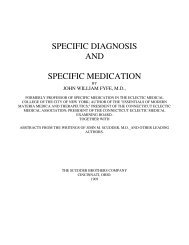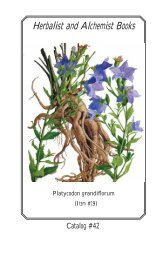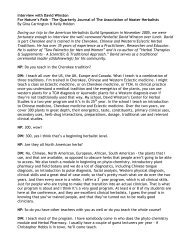MEDlCINAL PLANTS OF JAMAICA. PARTS 1 & 11.
MEDlCINAL PLANTS OF JAMAICA. PARTS 1 & 11.
MEDlCINAL PLANTS OF JAMAICA. PARTS 1 & 11.
Create successful ePaper yourself
Turn your PDF publications into a flip-book with our unique Google optimized e-Paper software.
GLIRICIDIA SEPIUM Steud. Quick Stick; Grow Stick; Growing Stake; Maranga.<br />
Under the name of Maranga, this species was pointed out to the authors as an ingredient of baths for<br />
fever and pain and of tea for colds. It seems possible that the common name used on this occasion was a<br />
corruption of Moringa transferred from M. oleifera. It was also said that the species is an excellent treatment for<br />
gonorrhoea. The same common name has been given on other occasions when it was said that the scraped root<br />
or the leaf is used in the treatment of kidney trouble, dropsy and jaundice. In this case it seems likely that not<br />
only the name but the uses had been transferred from Moringa. Under its usual vernacular name of quick stick it<br />
has been described to us as useful" as a cold cure. In Panama the leaves are applied as poultices to bruises, sores<br />
and erysipelas. (58).<br />
PISCIDIA PISCIPULA L. Jamaica Dogwood.<br />
The common name of the species probably derives from the fact that it is said to cure mange. A<br />
decoction of the bark is used in Jamaica for the relief of backache and other pains and to bathe sores. The plant,<br />
and especially the bark of the roots, is sedative and has been much used, especially in the United States of<br />
America, in the treatment of neuralgia, toothache, headache, mental worry, mania, uterine disorders and ulcers.<br />
In 1948 it was reported that Piscidia preparations were potent uterine depressants in various laboratory animals.<br />
The nature of the narcotic principles present in the bark seems to be in some doubt. They were said, at one time,<br />
to include "piscidin" but some of the later work indicated that this was a mixture of two substances which were<br />
not the active principles. According to some workers a curare-like akaloid is present. It also seems likely that<br />
saponin is present. Analyses carried out in 1944 showed that the root bark contains rotenone and a new<br />
substance which was called ichthynone. (1, 8, 9, 14, 15, 16, 19, 27, 30, 33, 37. 47, 50, 59).<br />
STYLOSANTHES VISCO SA Ws. Poor Man's Friend.<br />
It is now known that this species is distinguished from S. hamata Taub., by those who use medicinal<br />
herbs, on account of its strong smell. Moreover, it dries a much darker colour. It has some reputation in the<br />
treatment of pains such as stomach-ache: tea may be made or the plant may be soaked in proof rum and a few<br />
drops of the liquid be taken in water. One informant quoted its use for "nervous trouble". (See Mimosa pudica).<br />
(2, 7, 36).<br />
PASSIFLORACEAE<br />
PASSIFLORA MALIFORMIS L. Sweetcup.<br />
This may be boiled with the root of bryal wys and coconut leaf to make a tonic which is said to be "good<br />
for dark eyes-it nourishes the blood". The leaves of some species of Passiflora contain hydrocyanic acid. (27,<br />
36).<br />
PASSIFLORA RUBRA L. Goat Hoof: Goat Foot; Bull Hoof; Dutchman's Laudanum.<br />
Tea made from the stem and leaves of this plant is used in the treatment of colds. In Browne's time a<br />
decoction or syrup was used as a substitute for syrup of poppies or laudanum and the flowers were infused or<br />
pounded in wine or spirits. (5, 10, 62).<br />
PASSIFLORA SEXFLORA Juss. Duppy Pumpkin.<br />
The use of a plaster made with the leaves of this plant for sores and a lame foot is confirmed. (2).<br />
PHYTOLACCACEAE<br />
RIVINA HUMILIS L. Dog Blood; Bloodberry.<br />
For the treatment of colds a decoction of this species is sometimes used. The tea is also thought to be of<br />
use in cases of marasmus in babies. In combination with spirit weed (probably Eryngium) it is said to have<br />
produced a remarkable cure in the case of a child with a diseased eye. In Cuba the pounded leaves are used as a<br />
wound dressing and to treat catarrh. The berries are included in Maya prescriptions for dysentery and<br />
amenorrhoea. (47, 56).







